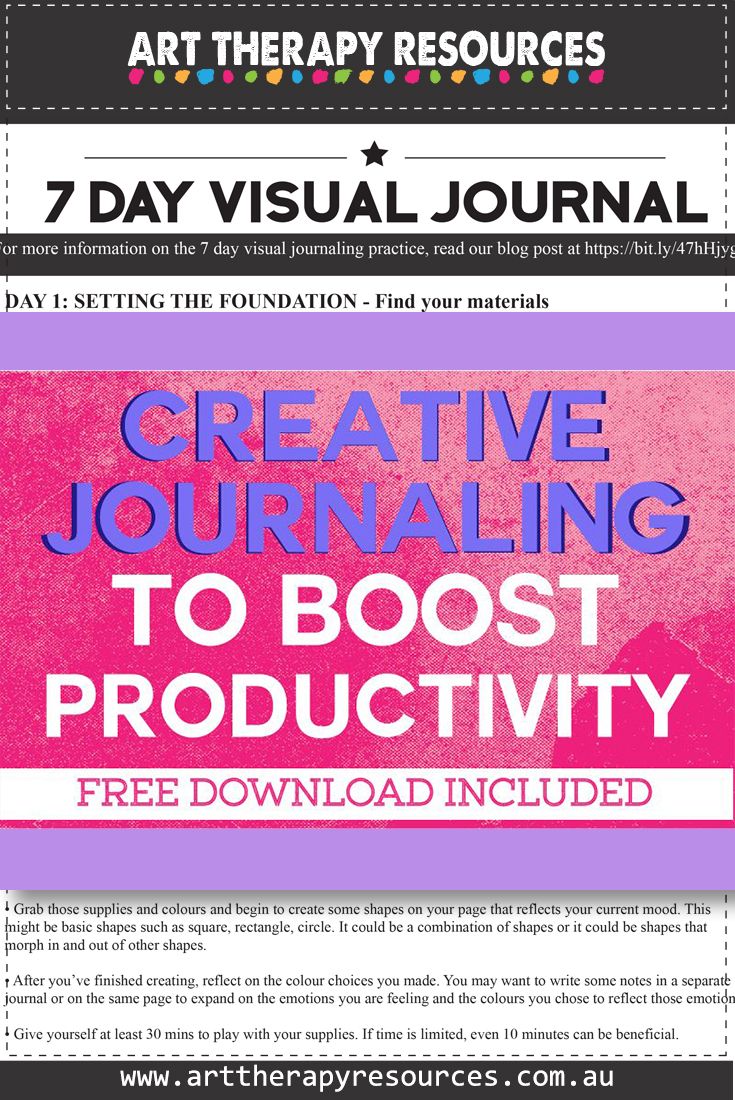THIS POST INCLUDES:
1. Power of Journaling
2. Journaling for Therapists
3. Building a Reflective Practice
4. Free Download Art Therapy Exercise
POWER OF JOURNALING

Journaling is a versatile and expressive practice that holds significant potential for art therapists seeking to enhance their productivity and creative capacities.
Journaling serves a dual purpose for art therapists: it is both a personal reflective tool and a professional development resource. By engaging in regular journaling, art therapists can document their experiences, insights, and emotional responses, thereby fostering self-awareness and emotional regulation. Additionally, journaling can be used to capture innovative therapeutic techniques and creative ideas that emerge during sessions, contributing to the therapist’s professional growth and repertoire.
For art therapists, self-awareness is crucial in maintaining a balanced and effective therapeutic practice. Journaling allows therapists to process their emotions, identify patterns in their thoughts and behaviors, and gain deeper insights into their professional interactions. By reflecting on their daily experiences, art therapists can enhance their emotional intelligence, which is essential for empathizing with clients and managing the complexities of therapeutic relationships.
Below we have identified from key areas where journaling can be used by art therapists. We’ve also included some ideas on journaling topics that art therapists can use for their personal and professional development. The main areas identified are:
- Self awareness and emotional regulation
- Creativity and innovation
- Professional development and goal setting
Prompts for Self-Awareness and Emotional Regulation:
1. Daily Reflection: Write about significant events of the day and your emotional responses to them.
2. Emotion Tracking: Document your mood throughout the day and analyze any triggers or patterns.
3. Therapeutic Interactions: Reflect on specific client interactions and your emotional reactions.
Journaling can also serve as a fertile ground for creativity and innovation in art therapy practices. By exploring new ideas, experimenting with different therapeutic approaches, and documenting creative inspirations, art therapists can continuously evolve their methodologies. Creative journaling can help therapists break out of routine patterns, encouraging them to think outside the box and develop unique interventions tailored to their clients’ needs.
Prompts for Creativity and Innovation:
1. Creative Brainstorming: Jot down new ideas for therapeutic activities or art projects.
2. Experimentation: Reflect on new techniques or materials you experimented with in sessions.
3. Client Progress: Write about successful interventions and consider ways to enhance them.
Incorporating journaling into professional development plans can help art therapists set and achieve their career goals. By regularly documenting progress, challenges, and achievements, therapists can maintain a clear vision of their professional trajectory. Journaling facilitates the tracking of continuing education activities, professional milestones, and areas for growth, ensuring a structured approach to career advancement.
Prompts for Professional Development:
1. Goal Setting: Outline your short-term and long-term professional goals.
2. Continuing Education: Document courses, workshops, and seminars attended, along with key takeaways.
3. Skill Assessment: Reflect on your strengths and areas for improvement as an art therapist.
PRACTICAL TIPS FOR JOURNALING
To maximize the benefits of journaling, art therapists could use the following for some practical tips:
1. Consistency: Establish a regular journaling routine, whether daily, weekly, or bi-weekly, to ensure continuous reflection and growth.
2. Environment: Create a conducive environment for journaling, free from distractions and interruptions.
3. Tools: Utilize a variety of journaling tools, such as traditional notebooks, digital apps, or audio recordings, to suit your preferences.
4. Openness: Approach journaling with an open mind, allowing for honest and uncensored self-expression.
5. Review: Periodically review your journal entries to identify recurring themes, insights, and areas for further exploration.
Journaling is an effective practice for art therapists and offers a myriad of benefits that enhance both personal and professional development. By engaging in reflective and creative journaling, art therapists can cultivate self-awareness, spark innovation, and achieve their career goals. Moreover, integrating journaling into therapeutic practice can provide clients with a powerful tool for self-expression and growth. Embracing journaling in these multifaceted ways can significantly enrich the art therapy profession, fostering continuous development and holistic well-being.
JOURNALING FOR THERAPISTS

Journaling is not merely a written exercise; it is a multifaceted tool for self-discovery and creative exploration. For art therapists, journals serve as an invaluable resource to document thoughts, emotions, and artistic expressions. This practice offers a space for personal and professional growth. By engaging in regular journaling, art therapists can cultivate a deeper understanding of their inner thoughts and emotions, thereby enhancing their therapeutic efficacy and personal well-being.
Journaling encompasses a broad spectrum of activities, from free writing and sketching to structured reflection and goal setting. This versatility allows art therapists to tailor their journaling practices to meet their unique needs and preferences. For instance, some therapists might prefer a traditional handwritten journal to capture their daily reflections, while others might opt for digital journaling tools that offer multimedia capabilities. Regardless of the medium, the act of journaling facilitates a continuous dialogue with oneself, fostering a deeper connection with one’s thoughts and emotions.
Adding a creative element to journaling allows for us to introduce some personal expressions that help us explore meaning to thoughts and feelings on a deeper level. Creative expression often reaches into the deeper levels of connection so that we can push beyond the surface level of our thoughts and emotions.
Creative journaling presents art therapists with unique opportunities for professional development. Integrating journaling into their routine enables therapists to refine their reflective practices, gain clarity on therapeutic techniques, and explore innovative approaches to art therapy.
REFLECTIVE PRACTICE
Reflective practice is a cornerstone of professional development in art therapy. Through journaling, therapists can engage in regular self-reflection, analyzing their experiences, emotions, and interactions. This process allows for a deeper understanding of one’s practice, highlighting areas of strength and identifying aspects that require further attention. By systematically documenting these reflections, therapists can track their progress over time, gaining valuable insights that inform their professional journey.
Practical Steps for Reflective Journaling:
1. Daily Reflections: Dedicate time each day to write about significant events and interactions, focusing on your emotional responses and professional insights.
2. Session Reviews: After each client session, jot down your observations, challenges faced, and any breakthroughs experienced.
3. Weekly Summaries: Compile a weekly summary of your reflections, identifying recurring themes and areas for growth.
Time is an important commodity for an art therapist, so it’s important to remember that not all journaling sessions need to take a long time. You can use smaller journaling sessions that simply focus on one emotion or thought that may be persisting. This can then be explored later on when you may have more time available.
GAINING CLARITY ON TECHNIQUES
Journaling provides a platform for art therapists to gain clarity on their therapeutic techniques. By documenting the methods and interventions used in sessions, therapists can evaluate their effectiveness and make necessary adjustments. This ongoing assessment ensures that therapeutic practices remain dynamic and responsive to clients’ needs. Note this process is not used to evaluate client sessions but instead used to identify therapeutic interventions you may have introduced in session that produced great results for your clients and you wish to reflect on that success.
Steps to Document Therapeutic Techniques:
1. Technique Tracking: Maintain a log of the techniques and interventions employed in each session, noting their outcomes and client reactions.
2. Comparative Analysis: Periodically compare different techniques to identify which ones yield the best results for specific issues.
3. Client Feedback: Incorporate (anonymous) client feedback into your journal to understand their perspective and refine your approach accordingly.
INNOVATION
Journaling serves as a breeding ground for innovation in art therapy. By capturing spontaneous ideas, experimental techniques, and creative inspirations, therapists can continually expand their repertoire. This proactive exploration fosters a culture of innovation, encouraging therapists to push the boundaries of traditional practices and discover new pathways to healing.
Steps to Foster Innovation:
1. Idea Brainstorming: Use your journal as a space to brainstorm new ideas and approaches, free from judgment or constraints.
2. Experiment Documentation: Record your experiments with new techniques, noting both successes and challenges encountered.
3. Collaborative Reflections: Engage with colleagues to share and discuss innovative ideas, incorporating their feedback into your journal.
DAILY PRACTICE JOURNALING
To fully harness the benefits of journaling, art therapists can integrate it into their daily practice. Establishing a consistent journaling routine can significantly enhance both personal and professional growth. Below are practical steps to incorporate journaling into your daily schedule.
Practical Steps for Daily Journaling:
1. Set a Schedule: Dedicate a specific time each day for journaling, ensuring it becomes a regular part of your routine.
2. Create a Conducive Environment: Choose a quiet and comfortable space for journaling, free from distractions.
3. Use Prompts: Utilize journaling prompts to stimulate reflection and creativity, particularly on days when you may feel stuck.
4. Be Consistent: Consistency is key to reaping the benefits of journaling. Even short, daily entries can lead to significant insights over time.
5. Review and Reflect: Regularly review your journal entries to identify patterns, celebrate progress, and set new goals.
Journaling is a vital practice for art therapists, offering numerous benefits for personal and professional development. By engaging in reflective and creative journaling, art therapists can cultivate self-awareness, refine therapeutic techniques, and explore innovative approaches. Integrating journaling into daily practice not only enhances individual growth but also contributes to the overall efficacy of therapeutic interventions.
BUILDING A REFLECTIVE PRACTICE

Journaling can be a useful tool for art therapists, serving as a reflective practice that nurtures both personal and professional growth. Prompts are essential in guiding this reflection, enabling therapists to delve deeply into their experiences, emotions, and methodologies. By engaging with thoughtfully crafted prompts, art therapists can gain valuable insights into their practice, enhancing their ability to support clients effectively.
PROMPTS FOR REFLECTIVE PRACTICE
Creative journaling begins with thoughtful prompts that encourage deep reflection. Art therapists can use prompts like “Reflect on a recent challenging session and identify a breakthrough moment” or “Describe how a particular art medium enhances your therapeutic connection.” These prompts stimulate introspection, helping therapists gain insights into their practice. Additional prompts could include:
– Session Reflections: “What emotions did you experience during your last session, and how did they influence your interactions with the client?”
– Client Progress: “Describe a client’s progress over the past month. What strategies contributed to their growth, and what challenges remain?” (NOTE: maintain confidentiality practices when journaling)
– Therapeutic Techniques: “Analyze a specific therapeutic technique you employed recently. How effective was it, and how might you modify it in future sessions?”
MAPPING PROFESSIONAL GOALS
Journaling serves as a dynamic tool for goal setting and tracking professional milestones. Art therapists can create sections in their journals dedicated to short-term and long-term goals. Regularly revisiting and updating these entries helps therapists stay focused, motivated, and aligned with their aspirations. For effective goal mapping, consider the following steps:
1. Identify Goals: Clearly define both short-term and long-term professional goals. These could range from mastering a new therapeutic technique to achieving a specific career milestone.
2. Action Plans: Break down each goal into actionable steps. Detail the resources, timeframes, and strategies required to achieve them.
3. Regular Review: Set aside time each week or month to review your progress. Reflect on what has been achieved, what obstacles have been encountered, and what adjustments are necessary.
4. Celebrate Milestones: Acknowledge and celebrate milestones reached. Recognizing achievements, no matter how small, fosters motivation and a sense of accomplishment.
By systematically mapping goals and milestones, art therapists can maintain a clear vision of their professional trajectory and remain committed to their continuous growth.
VISUAL COLLAGE
Collages can represent aspirations, challenges, or evolving therapeutic approaches. The act of visually organizing thoughts and ideas enhances creativity and provides a tangible representation of the therapist’s evolving journey. To create a visual collage:
1. Gather Materials: Collect images, textures, and colors from magazines, prints, or digital sources that resonate with your current professional and personal experiences.
2. Define Themes: Decide on themes for your collage, such as career goals, therapeutic breakthroughs, or personal challenges.
3. Arrange and Reflect: Arrange the images on your journal pages in a way that feels meaningful. Reflect on why you chose each element and what it represents in your professional journey.
4. Integrate with Writing: Combine the visual elements with written reflections to deepen your understanding and document your evolving thoughts.
NARRATIVE ART
This visual storytelling approach allows therapists to communicate complex emotions and experiences in a non-verbal, intuitive manner. It enhances creative expression and provides a unique perspective on their therapeutic practice. Steps to engage in narrative art journaling include:
1. Identify a Story: Choose a personal or professional story you wish to explore. It could be a memorable client session, a personal achievement, or a significant challenge.
2. Select Symbols: Identify images or symbols that represent different aspects of your story. These can be drawn, painted, or collaged.
3. Compose the Narrative: Arrange the symbols on the journal page to create a visual narrative. Consider the sequence and interaction of these elements.
4. Reflect and Write: Reflect on the visual story you have created. Write about the emotions and insights that arise from this process, deepening your understanding of the narrative.
FREE DOWNLOAD: Art Therapy Exercise
SIGN UP below to gain access to our RESOURCE LIBRARY and download the FREE 7 Day Journaling Plan.

BUILD YOUR ART THERAPY REFERENCE MATERIALS:
Pin this image to your Pinterest board.

SHARE KNOWLEDGE & PASS IT ON:
If you’ve enjoyed this post, please share it on Facebook, Twitter, Pinterest. Thank you!
